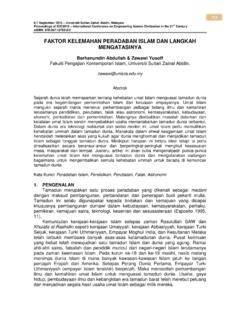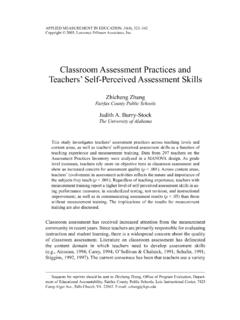Transcription of THE INFLUENCE OF SCHOOL ENVIRONMENT ON ACADEMIC ...
1 252. 6-7 September 2015 Universiti Sultan Zainal Abidin, Malaysia Proceedings of ICIC2015 International Conference on Empowering Islamic Civilization in the 21st Century e-ISBN: 978-967-13705-0-6. THE INFLUENCE OF SCHOOL ENVIRONMENT ON ACADEMIC . PERFORMANCE OF SECONDARY SCHOOL STUDENTS IN KUALA. TERENGGANU, MALAYSIA. Mudassir Ibrahim Usaini1 & Norsuhaily Abu bakar 2. 1. Med Psychology of Education Candidate, Faculty of Islamic Contemporary 2. Faculty of Applied Social Science University Sultan Zainal Abidin (UniSZA), Malaysia Abstract The aim of this study is to examine how SCHOOL ENVIRONMENT INFLUENCE students' ACADEMIC performance. The main objective of the study is to analyse how SCHOOL facilities, teachers and ENVIRONMENT significantly affect secondary SCHOOL students' ACADEMIC performance in Kuala Terengganu, Malaysia.
2 Descriptive Survey Research design was used in which data from 377 respondents was collected using self-administered questionnaire from 4 selected secondary schools within Kuala Terengganu. Stratified random sampling technique was used to sample the respondents. The data was analysed using regression analysis. The result is explained in three forms; Demographic information, descriptive analysis and inferential analysis. The result of the study indicated that students from a SCHOOL with adequate facilities, good teachers and favourable ENVIRONMENT perform well than those from schools with fewer facilities, unqualified teachers and the less enabling ENVIRONMENT . Finally, recommendations were given to parents, teachers, policy makers and educational administrators. Keywords: SCHOOL ENVIRONMENT , ACADEMIC performance 1.
3 INTRODUCTION. Byoung-suk, K. (2012) stated that children need safe, healthy and stimulating ENVIRONMENT in which to grow and learn. During the SCHOOL year, children can spend 6. to 8 hours at the SCHOOL where the ENVIRONMENT plays a significant/critical role in child development. More of the time is spent in the SCHOOL yard or travelling to and from SCHOOL . This condition requires careful planning and designing to optimize experiences that support education, health and stewardship. Therefore, the SCHOOL ENVIRONMENT is of paramount importance in shaping and reshaping intellectual ability. However, supportive and favourable SCHOOL ENVIRONMENT enriched with enough learning facilities, and favourable climate makes students more comfortable, more concentrated on their ACADEMIC activities that resulted in high ACADEMIC performance.
4 The forces of the ENVIRONMENT begin to INFLUENCE growth and development of the individual right from the womb of his mother. The educational process of development occurs in physical, social, cultural and psychological ENVIRONMENT . A. proper and adequate ENVIRONMENT is very much necessary for a fruitful learning of the child. The favourable SCHOOL ENVIRONMENT provides the necessary stimulus for learning experiences. The children spend most of their time in SCHOOL , and this SCHOOL ENVIRONMENT is exerting INFLUENCE on performance through curricular, teaching technique and relationship (Arul Lawrence 2012). 253. 6-7 September 2015 Universiti Sultan Zainal Abidin, Malaysia Proceedings of ICIC2015 International Conference on Empowering Islamic Civilization in the 21st Century e-ISBN: 978-967-13705-0-6.
5 However, educational institutions are intimately linked with society as a whole. They are the temple of knowledge and agent of social change and transformation. The general condition of our schools, colleges and universities are a matter of great concern to the nation. It plays a significant role in the development of the personality of the students. As the students spend most of their life at SCHOOL , the SCHOOL ENVIRONMENT is highly responsible for the inculcating of high values into them. For example, the Kothari Commission (1964-1966) posited that The destiny of Indian is now being shaped in her classroom ( ). This quotation indicated the significant role a SCHOOL ENVIRONMENT plays in a student in particular and nation in general. Therefore, student being a backbone of every nation need a healthy SCHOOL ENVIRONMENT that support them to perform well.
6 A document prepared by policy studies association (PSA) reviewed in 2014 in Washington indicated that students achievement is more heavily influenced by teacher quality than by students' race, class, prior ACADEMIC record or SCHOOL a student attend. This effect is particularly strong among students from low-income families and African-American students. The benefit being taught by good teachers are cumulative. Research indicated that the achievement gap widens each year between students with most effective teachers and those with less effective teachers. It suggests that the most significant gains in student achievement will likely be realised when students receive instruction from good teachers over consecutive years. Poor and minority students are the least likely group to be taught by teachers with experience, knowledge and credentials.
7 The elements of teacher quality that the researcher demonstrates are strongly associated with high students' achievement. Research also showed that these students produce most gains when assigned to competent teachers. Indeed, this finding leads to many researchers and analysts to assert that the lack of good teachers is the major contributor to the achievement gap. A Californian study suggested that schools hit a tipping point when approximately 20% of the SCHOOL faculty is comprised of unqualified teachers who do not meet minimum state requirements. After this point, schools begin to lose their ability to improve students' achievement. The best strategy for closing achievement gaps is to make sure that a SCHOOL serving poor and minority students have their fair share of qualified teachers.
8 2. LITERATURE REVIEW. Eric, S. (2005) in an article the role of the supportive SCHOOL ENVIRONMENT in promoting ACADEMIC success postulates that the SCHOOL ENVIRONMENT has broad INFLUENCE on students' learning and growth, including a significant aspect of their social, emotional and ethical development. When students find their SCHOOL ENVIRONMENT supportive and caring, they are less likely to become involved in substance abuse, violence and other problem behaviour. The research indicated that supportive schools foster these positive outcomes by promoting students sense of connectedness, belongingness or community. These terms are used interchangeably here to refer to students' sense of being in a close, respectful relationship with peers and adult at SCHOOL . Therefore, building in a SCHOOL community is a means of fostering ACADEMIC success.
9 Students who experience their SCHOOL as a caring community become more motivated, ambiguous and engage in their learning. In particular, 254. 6-7 September 2015 Universiti Sultan Zainal Abidin, Malaysia Proceedings of ICIC2015 International Conference on Empowering Islamic Civilization in the 21st Century e-ISBN: 978-967-13705-0-6. students' active connection with teachers and their perceptions that teachers care about them are what stimulate their effort and engagement. Another research by Oworye, (2011) showed that there is a significant difference between the ACADEMIC achievement of students in rural and urban secondary schools as measured by senior SCHOOL certificate examinations. To him, the geographical location of schools has a significant INFLUENCE on the ACADEMIC achievement of students.
10 Also he pointed out that uneven distribution of resources, poor SCHOOL mapping, facilities, problem of qualified teachers refusing appointment or not willing to perform well in isolated villages, lack of good road, poor communication, and nonchalant attitude of some communities to SCHOOL among others are some of the factors contributed to a wide gap between rural and urban secondary schools. Schools located in rural areas lack qualified teachers. It is because, they do not want going to rural areas that lack social amenities. They prefer to stay in urban schools. It is also observed that a lot of coaching of urban students is done to prepare them for public examinations, thus promoting the spirit of competition and rivalry that may be lacking in the rural pupils, probably, owing to limitations in exposure and experience.






